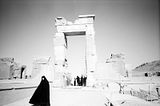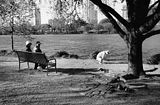
In a digital world, anything can be twisted, including time and, of course, this photograph.
Can a digitally manipulated image like this still be called photography? Many would say YES. They'd say that as long as the basis is still a photograph - an image created by a camera - a digitally manipulated image should still belong to photography. There are others, of course, who disagree. Call them purist or whatever, they do have their own valid arguments about what they believe photography should be.
Tuesday, November 25, 2008
Photo Exploration # 25: Twisted Time
Monday, November 24, 2008
Photo Exploration # 24: I still have yet to understand

What's the limit of an exploration?
I'd say, it's understanding. For as long as we have not reached a desirable and satisfactory understanding of what we set out to explore in the first place and of the answers found that have since generated more questions, that exploration shall not come to an end. Exploration in this sense, therefore, is the essence of our life's journey on its own. It is a never-ending quest to understand, to quench the thirst we were born with.
Our exploration - our life's journey - may consist of smaller, more manageable sub-explorations. Together, they form a stream - a huge stream - of life energy that keeps us moving, living. When that stream stops flowing, that is to say when our quests for answers have stopped, then that's when life ends.
This photo is part of that smaller sub-exploration of mine of the wonder of the visual world; how I come to like what I see, what moves me to cast the spell of camera magic and freeze it in a frame, and how that interplay of the inner and outer worlds in that simple act of pressing the button of the camera gives me so much satisfaction (or dissatisfaction) to me.
Please do forgive me for these visual and verbal ramblings ...
Eki Qushay Akhwan
Sunday, November 23, 2008
Photo Exploration # 23: Feet and Stillettos

Feet and stillettos ... two things that go together.
As you can obviously see, this photo is heavily cropped at the top and a little bit at the bottom. I did it to get rid of the extraneous visual elements that will distract attention from the main point (the point of interest) of this photograph. The compositional simplification I did to this photo, I think, helps accentuate the feet (both of the girl's and the chair's), and hence articulates the impact I want to achieve in presenting the subject.
Now the question is, how much cropping are we allowed to perform in photography?
There are no exact guideline to this. Some photographers, like Henri Cartier-Bresson, simply oppose after-the-fact cropping as, according to him, it would destroy the "geometrically correct interplay of proportions" of the original scene. Many other photographers, of course, have more linient attitude about cropping.
Generally speaking, however, cropping is a very useful way of enhancing a photograph's composition. It does so by removing unwanted or distracting elements, correcting compositional balance, or hiding/covering a framing mistake. It also helps create the visual impacts you want with your photograph.
Text and photo by Eki Qushay Akhwan.
Saturday, November 8, 2008
Photo Exploration # 22: Small Things and Affinities to Visual Elements

To me it's still a mystery why some people (read: photographers) are more attracted to a particular type of visual stimuli. Some of them obviously have more affinity to landscape, some to human expressions or lines and geometry, and others to other visual elements such as light, colors, textures, and other more subtle hues of image-making that not everybody can even "see".
I understand that people with greater visual intelligence pay attention to all those elements. But evidence also shows that their attention is not directed equally to every one of them.
As a photographer, I have learned to feel comfortable with different subject matters with my camera. I can do landscape as comfortably as portraiture, architecture and abstract as dexterously as street photography, but when it comes to visual stimuli, I think lines and geometry are what I am attracted to the most. My reactions to them are almost always spontaneous - it's like I can see them even when they are not tangibly manifested.
By the way .........
I "discovered" the above photo at the reception desk of a car and motorbike wash. The encounter was brief and my reaction to the visual stimulus was spontaneous. As I would normally do in such an encounter, I explored the scene, taking several pictures of it without thinking much. I did not know why I was attracted to this object, but when I saw the results, I think it's mostly the lines, the curves, and the geometry of it that had triggered my instinctive photographic reaction in the first place.
Wednesday, November 5, 2008
Photo Exploration # 21: Street Photography?

Is a moment snapped from the street (or public space for that matter) necessarily a street photography?
Convention has it that street photography is (should be):
- a photo taken at a public place (of which the street is part);
- a photo that focuses on a candid action of a human being or human beings; and ...
- ???
I wrote about it once here. But is this one really a street photography? What makes it so? Or not so?
Unless otherwise stated, the articles and photos in this blog are the copyright property of Eki Qushay Akhwan. All rights reserved. You may NOT republish any of them in any forms without prior permission in writing from Eki Qushay Akhwan.
Kecuali disebutkan secara khusus, hak cipta atas tulisan dan karya foto di dalam blog ini ada pada Eki Qushay Akhwan. Dilarang mempublikasi ulang artikel dan/atau karya foto di dalam blog ini dalam bentuk apapun tanpa izin tertulis dari Eki Qushay Akhwan.







.jpg)








